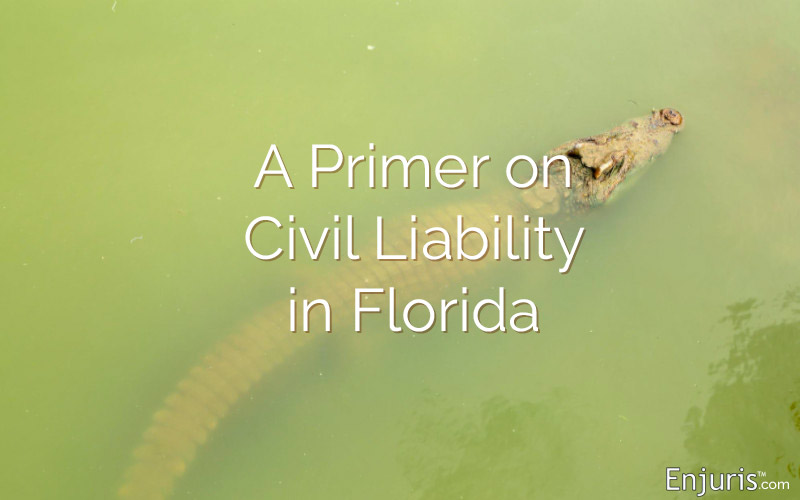
Negligence, intentional torts and strict liability
Florida is popular for many things: sunshine, great beaches, vacation spots... and insane news headlines that lead to liability.
What is liability? This is a term used to indicate legal responsibility.
There is criminal liability, which is used for the heavier cases you see on television shows like Law & Order – murder, assault and things like that.
Civil liability, on the other hand, is taking responsibility for doing harm to another person for things like a car accident, an oil spill or other forms of negligence. That person has committed a tort (a personal injury, not a fancy cake) and must compensate the individual who was hurt.
This can usually be achieved with a settlement and not a full court trial. In some cases, it might proceed to alternative dispute resolution, and in rare cases, it will proceed to a personal injury trial with a judge and jury.
The three major types of torts (or wrongful acts) that lead to legal liability include:
- Negligence torts (e.g., car accidents)
- Intentional torts (e.g., assault and battery)
- Strict liability torts (e.g., products liability)
Negligence torts
These are the most common types of torts. They’re non-deliberate and mostly careless; think of another person crashing their car into yours, for instance. They were probably looking at their GPS or trying to find a street name, not deliberately playing bumper cars.
Most of the time, the defendant has the trust of the victim and failed in his or her duty. Criminal negligence occurs when someone is severely injured because of the negligent act; civil negligence occurs when the act results in a lesser harm, like someone slipping and falling because an employee forgot to put up a “Wet Floor” sign after mopping.
Florida negligence case example: nursing home negligence
In 2013, a Polk County jury handed down a verdict of $1.1 billion dollars to the plaintiffs in a nursing home negligence suit. The plaintiff, Arlene Townsend, had repeatedly fallen while living at the nursing home and was not properly supervised. The nursing home did not even participate in the lawsuit, and the judge asked the jury not to consider liability, but only damages. They considered the case for little more than an hour before returning with the verdict.
Intentional torts
These are committed when the defendant has a clear intent to cause harm. What was he thinking? What did he want to do? The harm was not caused by accident or neglect; it was planned. This can be against a person or property.
Common examples include:
- Battery: hurting a person through physical acts or by using an object (e.g., a gun, a bat, etc.);
- Assault: threatening to commit battery, though no injury occurred; and
- Defamation: speaking lies about another that result in some kind of harm.
Florida intentional tort case: Stolen SUV in Ocala
Here we have the infamous “Florida Man”, who has his own thread on Reddit and Twitter handle. Florida Man is known for his horrible hijinks and tomfoolery, and this time he was arrested for driving an SUV through a showroom floor and taking two large-screen televisions with him when he left. He claims he doesn’t remember committing the crimes, which might be a defense for the “intentional” part of the intentional tort, but that remains to be seen.
Strict liability torts
Strict liability cases don’t take the mental component into account. If a defendant’s actions caused damage that fulfilled the statute’s requirements, then that person is liable under the law. This will apply even if the circumstances were out of the defendant’s control.
Examples include:
- Dangerous acts: if an individual decides to engage in a dangerous act, then they’re putting others at risk, too (e.g., firing a gun at a target and accidentally hitting someone else);
- Animals: if an animal owned by the defendant gets away and bites someone, the owner will be held liable;
- Products liability: suppliers are held responsible for the products that they put into the market.
Florida strict liability case: products liability for defective airbag
In 2016, airbag company Takata settled with a Florida woman, Patricia Mincey, who was left a quadriplegic after a 2014 crash. Four days after her car accident, her 2001 Honda Civic was recalled. Under the conditions of the agreement, the terms were not disclosed. In her case, the airbag did not rupture, but deployed with too much force, sending deadly metal fragments flying.
If you have a moment, tell our readers about your case! You can submit it here or leave a comment on any post on our blog.
See our guide Choosing a personal injury attorney.
